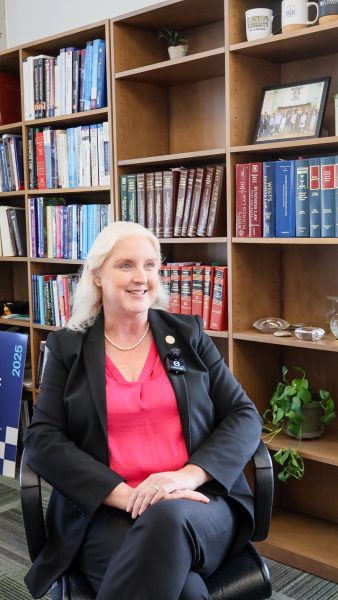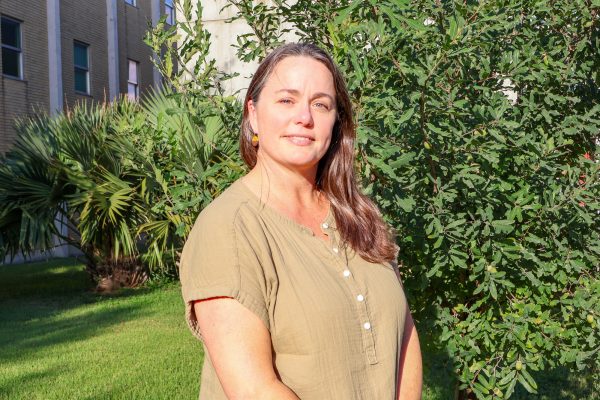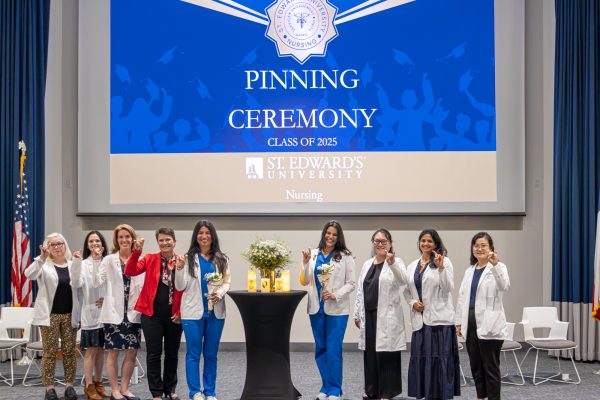Lectures explores global health
Students and professionals filled the Jones Auditorium in the Robert and Pearle Ragsdale Center for the annual Brother Lucian Blersch Global Health and Infectious Disease Symposium. The Oct. 19 lectures focused on the topic of pathogenic proteins.
Speakers ranged from chemists to public health workers. Their presentations centered around global health and diseases such as Alzheimer’s or Huntington’s Disease that come from illness-causing proteins. They also explored the relationship between society and disease.
“I thought it was really interesting to see the relationship between poverty and inequality and health,” senior biology major Amara Garza said. “One of the best ways to decrease these diseases is by increasing the education of mothers.”
The symposium kicked off with St. Edward’s University’s Eamonn Healy, Brother Lucian Blersch professor of science and of chemistry, who explained his research on the relationship between proteins and diseases, which can be diagnosed similarly to diseases like Huntington’s. This disease, along with the others explored at the symposium, is caused by a misfolded protein and, according to Healy, can be better understood by examining these proteins.
“I was particularly interested in Dr. Healy’s talk because we do not know enough about these diseases,” freshman and international business major Sarah Bugh said. “There are always areas to be explored.”
After Healy came Lary Walker, research professor of neuroscience at Emory University. He applied modern medicine’s understanding of Koch’s postulates, the four requirements necessary to link a microbe with a disease, to the explanation of infectious proteins. Walker said that these postulates can also be used to link proteins with diseases, in the case of Huntington’s or Alzheimer’s, for example.
Following the theories of Healy and Walker was Neil Cashman, a professor of medicine and the Canada Research Chair of the Brain Research Center at the University of British Columbia, who explained the way that these diseases are transferred and posed a few solutions to ending their spread.
“Dr. Cashman was my favorite lecturer,” sophomore biology major Janaee Wallace said. “His proposal for how to cure Alzheimer’s and Huntington’s Disease was one of the things I was clearly focusing on. I also really like that he offered a clear resolution to the issue at hand.”
Simonetta Sipione, assistant professor of pharmacology and Canada Research Chair in the Neurobiology of Huntington’s Disease at the University of Alberta, rounded off the morning with a lecture on the molecular mechanisms underlying the treatment of Huntington’s and explained her experimental approach to the treatment and understanding of Huntington’s.
Following a lunch break, the lecturers’ focus shifted from the chemistry of disease to the challenges that global health faces.
Kira Fortune, a member of the Pan-American Health Organization, gave a lecture exploring some of global health’s main challenges such as poverty and women’s education. Fortune also addressed the ways that these challenges can be overcome.
“I was interested to learn the different areas of health and the importance of having proper healthcare,” freshman international business major Sarah Fumagalli said. “Healthcare is not just important for women and old people. It impacts everyone.”
The last lecture of the day came from Elizabeth Gibbons, distinguished fellow at the Kozmetsky Center of Excellence in Global Finance at St. Edward’s and visiting scientist at Harvard’s FXB Center for Health and Human Rights. Gibbons explained the strong correlation between poverty and disease and explained that the best way to solve these problems is through eliminating economic inequality.
“I liked Dr. Gibbons’ talk about socio-economic status,” Wallace said. “I thought it was interesting to see how your place is the socio-economic ladder determined how susceptible you would be to certain diseases.”
The symposium ended with a panel discussion between all of the speakers who debated topics of global health while also fielding questions from the audience. The discussion allowed the participants to cover all of the questions that the audience perceived in their conversation about global health.
“I appreciated Dr. Gibbons’ explanation of the relationship between poverty and disease,” Walker said. “I never really thought how much social status was related to the survival rate of children. I was also interested in the way that countries like China and Cuba were working to help their citizens.”
A morning of conversation and debate provided students the opportunity to engage in the world of academia while also dealing with a topic that interested students.
“As a biology major, I came here to learn more about the issues facing global health today,” Garza said. “I am interested in how politics impact disease, and how to deal with it across the board.”






